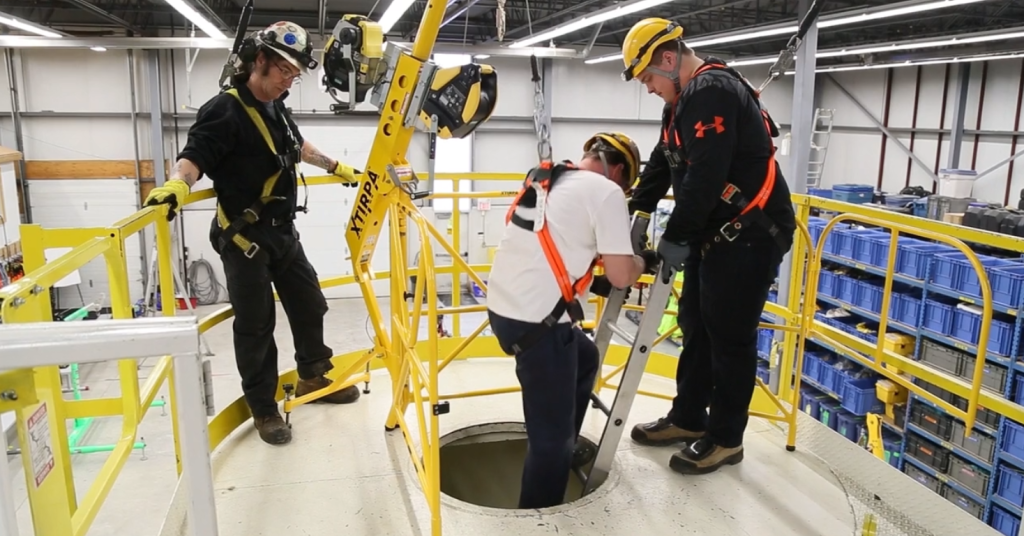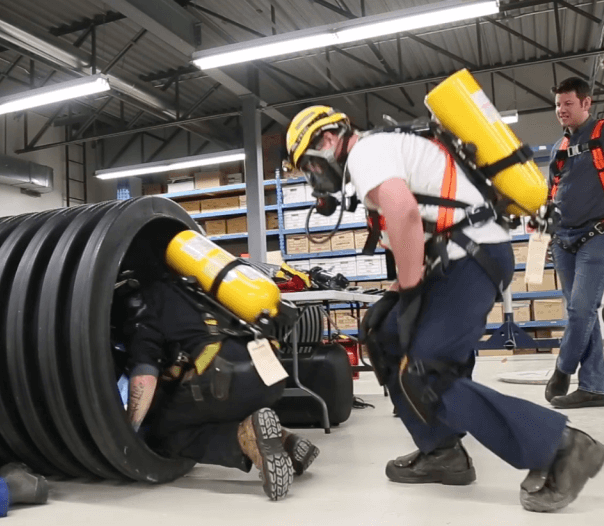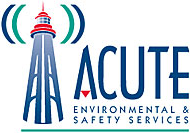The CCOHS cites that about 60% of the causalities relating to confined space hazards are would-be rescuers, who did not have adequate rescue training or awareness of confined space training Ontario. ACUTE strives to enable workers to return safely to their families at the end of the day by offering industry-proven training to reduce injuries and causalities.
This article discusses confined space training and the process of certification, legal requirements for employers, and regulations. Click on each corresponding link to jump ahead:
- Confined Space Training Ontario – Certification
- Confined Space Training Ontario – Legal Requirements for Employers
- Confined Space Training Ontario – Regulations
- What is a Confined Space?
Contact our team of qualified professionals to learn more about confined space training Ontario requirements.
Note: This page on Confined Space Training in Ontario has been prepared as a resource summary and central location for related links to help workplace parties and employers understand some of their obligations under the Ontario Occupational Health and Safety Act (OHSA). It is not legal advice.
Confined Space Training Ontario – Everything to Know
1. Confined Space Training Ontario – Certification

Did you know that is is the employer’s responsibility to set up confined space training Ontario?
As of the writing of this article (December 2023), there is no formal confined space certification process employed by the Ministry of Labour, Immigration, Training and Skills Development. In addition, there is no formal certification process for trainers, workers, training programs or agencies at this time. It is up to the employer, in consultation with the JHSC or health and safety representative, if any, to determine the level and type of training provided, and to ensure it is adequate for the type of entry being conducted.
Source: http://www.labour.gov.on.ca/english/hs/pubs/confined/cs_9.php
2. Confined Space Training Ontario – Legal Requirements For Employers

Organizations/employers are required to develop a written confined space program.
Organizations are required to develop a written confined space program (632/05 section 5) for confined spaces in their workplace. There are six parts to a confined space program:
- Part 1: Recognize or identify a confined space (O. Reg. 95/11, s. 4.)
- Part 2: Assess the confined space hazards (O. Reg. 632/05, s. 6 (1).)
- Part 3: Control the hazards of each confined space by developing a plan (O. Reg. 632/05, s. 7 (1).)
- Identify communication protocols
- Define work procedures
- Identify equipment(rescue and protective) to be used
- Define the duties of workers
- Establish means of entering and exiting
- Define procedures for ventilation and purging
- Determine isolation and control of the material environment
- Define atmospheric testing parameters/procedures
- Provide general training for workers
- Create a permit system
- Part 4: Ensure that entry permits are issued before work is conducted in a confined space (O. Reg. 632/05, s. 10 (1))
- Part 5: Communicate program and plans to the JH&SC. For project sites, the company must provide this to the contractor for dissemination (O. Reg. 95/11, s. 4.)
- Part 6: Review plans as often as necessary with JH&SC or a safety representative to ensure adequacy (O. Reg. 632/05, s. 7 (5))
Refer to the Confined Space Guideline on the Ministry of Labour, Immigration, Training and Skills Development’s website for additional information on how to recognize and assess your confined space, and on how to create your confined space plan.
Source: Health and Safety Ontario
3. Confined Space Training Ontario – Regulations

If you work in confined spaces, regardless of how often, you need confined space training Ontario!
All employees entering confined spaces and all employees contributing to the work involving confined spaces need to engage in confined space training Ontario. There are different regulations for non-project and project site workplaces.
A) Workplaces
For workplaces, the training required for each individual includes:
- Recognition and identification of potential hazards associated with the confined spaces that will be entered
- Evaluation and control procedures for the identified or potential hazards
- Hands-on training for pertinent equipment such as ventilation equipment (blowers), harnesses, and air quality monitors (e.g., oxygen/combustible meters) that will be used in the confined space
- Hands-on training for all personal protective equipment (e.g., respirators)
- Procedures for entering the confined space.
- Procedures to follow in the event of a situation or emergency that could present additional risk to the worker
- The specific work to be done while in the confined space
- Rescue Plan training
- Maintenance of written records on training history and delivery in the workplace shared with JH&SC
- Refresher training is recommended at least annually or in consultation with JH&SC
A well-balanced mix of hands-on work and theoretical work will ensure your confined space training Ontario is sufficient.

B) Project Site Workplaces
The following are specific requirements for project site workplaces:
- Every worker leaving or entering a confined space receives adequate training to perform work safely
- Identification of confined space hazards
- Relevant training on safe work practices
- Records maintenance on which workers received training, the training content, when it was delivered, and who was the instructor, provided to the project’s safety committee or representative.
Note: This concise summary has been prepared to help organizations understand significant obligations under the Occupational Health and Safety Act (OHSA) and related regulations. It is not legal advice.
Here are some resources you can view:
- To view a summary from the Government of Ontario explaining employer and worker requirements, click here.
- To view the Ontario Regulations for confined spaces, click here.
- For confined space rescue guidelines, click here.
Next, we will examine different types of confined spaces and their unique hazards.
4. What is a Confined Space?
Continue reading and watching to get familiar with what a confined space is and what the hazards are that workers face in these environments.
Watch the video above to learn how to identify a confined space.
A confined space means a fully or partially enclosed space:
- That is not designed or constructed for continuous human occupancy
- In which atmospheric hazards may occur because of its construction, location, or contents, or because of work that is done in it
For more information on confined space and examples, refer to this Confined Space Training Ontario resource page.
A) Examples of Confined Spaces
Confined spaces take many forms, here are some examples of potential confined spaces:
|
|
If you work in any of these confined spaces, visit our online calendar to set up your confined space training Ontario.

B) Hazards Associated With Confined Spaces
The following are the hazards that are typically faced by your team members when exposed to confined spaces:
- Hazardous chemical exposure
- Poor and polluted air quality
- Fire hazards
- Residual chemical process exposure
- Noise
- Radiation
Further, the CCOH also notes that there are unique challenges for workers deployed in confined space assignments, some of which include:
- Limited accessibility to exits makes it difficult for employees to retreat to safety
- Dynamic conditions mean added risk as multiple hazards may materialize
- The confined space makes it difficult to secure the team or workers exposed
- During the process of work, new hazards may be introduced
For additional hazards and an insightful resource see CCOH’s resource on confined space.
Need Confined Space Training? Rely on Acute Safety

ACUTE can transform your workplace to be more safety-compliant.
If you are in charge of supervising health and safety in the workplace or you are concerned that your workplace is not safety complaint, or you need confined space training, book a course with ACUTE. Here are some of the benefits of working with ACUTE:
- Open Door Instructor-Student Partnership – ACUTE’s training services emphasize client participation, staff foster relationships with clients and serve as a touchstone for advice anytime moving forward.
- Serving Your Team and Industry – With a vast array of clients in manufacturing, construction, health, academic, and government sectors, ACUTE brings the best safety practices from across the spectrum to your workplace.
- 100 Years Combined Experience – ACUTE provides comprehensive health and safety training, on-site safety services, and consulting services. With over 100 years of combined experience, our company staff offers more than theoretical or abstract ideas. ACUTE offers solutions!
- Track Record of Success – ACUTE is rated 4.9/5 stars on Google reviews, demonstrating our commitment to our clients, our quality, and our passion for training.
It is one thing to understand what HSE is and another to know how to conduct an HSE presentation. Contact Acute Environmental today to learn more about health, safety, and the environment.
What Our Customers Are Saying…
We were referred to ACUTE on behalf of our employer for an n95 mask fitting – the staff here are professional, personable, and informative.
I’d come back here for any safety-related training in a heartbeat.
Acute has been a staple in supporting my companies over the years and have always delivered quality and dependable service. Training programs are top shelf and a great facility for practical application. couldn’t recommend them more. keep up the great work folks.
Outstanding service provided by Acute, right from the customer support end, right through to the delivery of the session. Always professional, quick to respond, and always delivering services that exceed my expectations. Acute has an amazing team that is always helping us achieve better health and safety performance. So are grateful to have such a tremendous resource in Acute!
Hours of Operation and Contact Information:
Monday-Friday: 8:00 AM – 5:00 PM
Saturday-Sunday: Closed
Phone: (519) 747-5075
Fax: (519) 747-4608
Email: info@acuteservices.com

